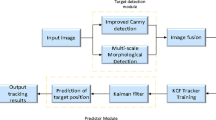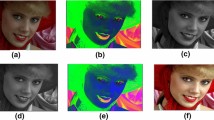Abstract
Considering the robustness, stability and reduced volume of data, researchers have focused on using edge information in various video processing applications including moving object detection, tracking and target recognition. Though the edge information is more robust compared to intensity, it also exhibits variations in different frames due to illumination change and noise. In addition to this, the amount of variation varies from edge to edge. Thus, without making use of this variability information, it is difficult to obtain an optimal performance during edge matching. However, traditional edge pixel-based methods do not keep structural information of edges and thus they are not suitable to extract and hold this variability information. To achieve this, we represent edges as segments that make use of the structural and relational information of edges to allow extraction of this variability information. During edge matching, existing algorithms do not handle the size, positional and rotational variations to deal with edges of arbitrary shapes. In this paper, we propose a knowledge-based flexible edge matching algorithm where knowledge is obtained from the statistics on the environmental dynamics, and flexibility is to deal with the arbitrary shape and the geometric variations of edges by making use of this knowledge. In this paper, we detailed the effectiveness of the proposed matching algorithm in moving object detection and also indicated its suitability in other applications like target detection and tracking.
Similar content being viewed by others
References
Yokoyama M, Poggio T (2005) A contour-based moving object detection and tracking. In: Int’l workshop on visual surveillance and performance evaluation of tracking and surveillance, pp 271–276
Dewan MAA, Hossain MJ, Chae O (2008) An adaptive motion segmentation for automated video surveillance. EURASIP J Adv Signal Process 187413:1–13
Bahadori S, Iocchi L, Leone GR, Nardi D, Scozzafava L (2007) Real-time people localization and tracking through fixed stereo vision. Appl Intell 26:83–97
Kim C, Hwang JN (2002) Fast and automatic video object segmentation and tracking for content-based applications. IEEE Trans Circuits Syst Video Technol 12(2):122–129
Schmid C, Zisserman A (1997) Automatic line matching across views. In: IEEE conference on computer vision and pattern recognition, pp 666–671
Aider OA, Hoppnot P, Colle E (2002) A model to image straight line matching method for vision-based indoor mobile robot self-location. In: IEEE international conference on intelligent robots and system, vol 1, pp 460–465
Arkin EM, Chew LP, Huttenlocher DP, Kedem K, Mitchell JSB (1991) An efficiently computable metric for comparing polygonal shapes. IEEE Trans Pattern Anal Mach Intell 13(3):209–216
Cakmakov D, Celakoska E (2005) Shape matching of digital curves. In: IEEE international symposium on image and signal processing and analysis, pp 457–461
An SY, Kang JG, Choi WS, Oh SY (2010) A neural network based retrainable framework for robust object recognition with application to mobile robotics. Appl Intell 1–21
Dailey DJ, Cathey FW, Pumrin S (2000) An algorithm to estimate mean traffic speed using un-calibrated cameras. IEEE Trans Intell Transp Syst 1(2):98–107
Sappa AD, Dornaika F (2006) An edge-based approach to motion detection. Lect Notes Comput Sci 3991(1):563–570
Dewan MAA, Hossain MJ, Chae OS (2009) Background independent moving object segmentation for video surveillance. IEICE Trans Commun E92-B(2):1–14
Hossain MJ, Dewan MAA, Chae OS (2007) Moving object detection for real time video surveillance: an edge segment based approach. IEICE Trans Commun E90-B(12):3654–3664
Hossain MJ, Dewan MAA, Chae OS (2008) Edge segment based automatic video surveillance. EURASIP J Adv Signal Process 2008:743202
Hossain MJ, Dewan MAA, Chae OS (2007) Suitability of edge segment based moving object detection for real time video surveillance. Lect Notes Artif Intell 3398(I):526–533
Cirrincione G (2003) A novel self-organizing neural network for motion segmentation. Appl Intell 18:27–35
Risinger L, Kaikhah K (2008) Motion detection and object tracking with discrete leaky integrate-and-fire neurons. Appl Intell 29:248–262
Gorman GW, Mitchell OR, Kuhl FP (1988) Partial shape recognition using dynamic programming. IEEE Trans Pattern Anal Mach Intell 10(2):257–266
Turney JL, Mudge TN, Volzz RA (1985) Recognizing partially occluded parts. IEEE Trans Pattern Anal Mach Intell 7(4):410–421
Valova I, Milano G, Bowen K, Gueorguieva N (2010) Bridging the fuzzy, neural and evolutionary paradigms for automatic target recognition. Appl Intell 1–15
Makarov A, Vesin JM, Kunt M (1994) Intrusion detection using extraction of moving edges. In: Proceedings of international conference on computer vision and image processing, vol 1, pp 804–807
Huang PW, Dai SK, Lin PL (1999) Planar shape recognition by directional flow-change method. Pattern Recognit Lett 20:163–170
Dubuisson MP, Jain AE (1994) A modified hausdorff distance for object matching. In: IEEE international conference on pattern recognition, vol 1, pp 566–568
Borgefors G (1988) Hierarchical chamfer matching: a parametric edge matching algorithm. IEEE Trans Pattern Anal Mach Intell 10(6):849–865
Latecki LJ, Lakamper R, Wolter D (2003) Shape similarity and visual parts. In: Proceedings of international conference on discrete geometry for computer imagery, pp 34–51
Ireton MA, Oakley JP, Xydeas CS (1992) An hierarchical classification method and its application in shape representation. In: Proceedings of the SPIE image storage and retrieval systems, vol 1662, pp 154–165
Canny J (1986) A computational approach to edge detection. IEEE Trans Pattern Anal Mach Intell 8(6):679–698
Lee JH, Cho YT, Heo H, Chae OS (2005) MTES: visual programming for teaching and research in image processing. Lect Notes Comput Sci 3514:1035–1042
Zhao Q, Tao JKH, Hua W (2006) Part based human tracking in a multiple cues fusion framework. In: IEEE international conference on pattern recognition, vol 1, pp 450–455
Author information
Authors and Affiliations
Corresponding author
Additional information
This research was supported by the Basic Science Research Program through the National Research Foundation of Korea (NRF) funded by the Ministry of Education, Science and Technology (2010-0015908) and by a grant from the Kyung Hee University in 2010 (KHU-20101372).
Rights and permissions
About this article
Cite this article
Hossain, M.J., Dewan, M.A.A. & Chae, O. A flexible edge matching technique for object detection in dynamic environment. Appl Intell 36, 638–648 (2012). https://doi.org/10.1007/s10489-011-0281-4
Published:
Issue Date:
DOI: https://doi.org/10.1007/s10489-011-0281-4




